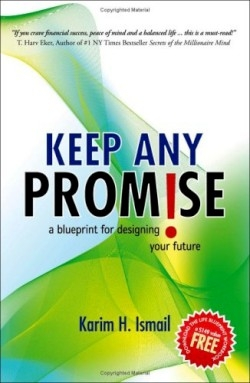Keep Any Promise
A Blueprint for Designing Your Future
The Phoenix myth in one form or another flies across cultures as much a part of the human spirit as our knowledge that grass dies away in winter and flourishes green again in spring.
Karim Ismail tasted the ashes of failure and he writes that he has risen again on the wings of success. Dealing with financial problems and chronic pain Ismail says “All my dreams and promises to myself lay in tatters. My dream of making a meaningful impact on the world was crumbling around me.”
A Kenyan immigrant to Canada Ismail had enjoyed “corporate success with a master’s degree in business” and so he decided to apply those techniques that had made him professionally successful to his deteriorating personal life.
In Keep Any Promise Ismail offers readers a chance to follow his example. His techniques combine the Law of Attraction Tony Robbins’ personal power thinking and Marianne Williamson’s spiritual offerings into a stew that some people will find nourishing.
But the author believes that the book is valuable even for readers who are not mired in emotional spiritual or professional mud. Skip part one if “you have a reasonable amount of success in achieving your goals.” Go straight to part three if you “generally feel very good about your life” he advises.
Ismail’s personal experience aside much of his source material seems derivative of thinkers like Viktor Frankl and &201mile Coué. Frankl believed in the power of will: “the ability to choose one’s attitude in any given set of circumstances.” Coué proposed optimistic autosuggestion: “Every day in every way I’m getting better and better.”
The chapters in part one of Keep Any Promise (“How Can I Get There?”) center around finding important and audacious goals setting a time-frame and measure of achievement and then visualization sharing seeking assistance etc. Each chapter’s ideal is illustrated with an anecdotal experience. Part two (“How Do I Implement My Goals and Stay Focused?”) is shorter and encompasses questions and examples. As in parts one and three there are worksheets. Part three (“The Big Life Questions”) speaks to discovering one’s life purpose forgiveness and affirmation. All chapters begin with aphorisms from the notables like Dale Carnegie Martin Luther King Jr. and Norman Vincent Peale.
Obviously Ismail has explored and deepened his emotional and spiritual knowledge and with this book he shares some sound principles for living successfully. He has also taken his methodology into the wired world. Purchasers can access Ismail’s Web site to employ a Life Blueprint Workbook.
The book ends with five pages of resources Ismail used in developing his Promise citing people ranging from the aforementioned Williamson and Robbins to Dan Sullivan Eckhart Tolle James Allen Wayne Dyer and Deepak Chopra.
Keep Any Promise can certainly be a useful tool but the element that the author doesn’t address sufficiently is how a person caught in despair and trapped in failure can manifest the will to act. As Bodhidharma offered long ago “All know the way; few actually walk it.”
Disclosure: This article is not an endorsement, but a review. The publisher of this book provided free copies of the book and paid a small fee to have their book reviewed by a professional reviewer. Foreword Reviews and Clarion Reviews make no guarantee that the publisher will receive a positive review. Foreword Magazine, Inc. is disclosing this in accordance with the Federal Trade Commission’s 16 CFR, Part 255.

